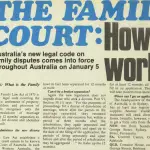
The Family Court of Australia is a Federal court that deals exclusively with family law disputes, including separation and divorce, child custody and matters pertaining to children. The Family Court was established by the Gough Whitlam-led Labor government in 1975, with the passing of the Family Law Act. During the development of this legislation, the States were asked to refer their family law powers to the Commonwealth. All agreed except for Western Australia, which retained – and continues to operate – its own Family Court. The Family Court of Australia began operation in January 1976. The main Family Court building is located in Melbourne, however, the Family Court conducts hearings at locations around Australia (except Western Australia).
Today, most straightforward matters of family law – almost three-quarters of all family law cases, in fact – are actually dealt with by the Federal Magistrates’ Court. The Family Court now concentrates mainly on complex and conflicted cases, as well as disputes involving considerable amounts of property. According to its website, the Family Court considers cases involving multiple parties, including those involving a child welfare agency; allegations of sexual abuse or serious physical abuse of a child; family violence or mental health issues. It also considers cases involving multiple expert witnesses, complex questions of law and/or special jurisdictional issues, international child abduction under the Hague Convention, special medical procedures and international relocation.
The evolution of the Family Court is an example of how both the law and Federal-State powers have changed over time. Family law is one area of law where the Commonwealth has assumed considerable power from the States, through both legislation and the voluntary referral of powers by the States. The Whitlam government’s Family Law Act (1975) contained a host of reforms to family law and changed the nature of divorce in Australia. Divorce had previously been a State responsibility and divorce laws and requirements differed from State to State. To be granted divorce one party generally had to “show grounds” by proving adultery, desertion, insanity, alcoholism or violent behaviour by their spouse. The 1975 act ended this by introducing a “no fault” process, where the applicants only had to show the marriage had broken down irretrievably and they had been living separately for 12 months. Divorce not only became easier to achieve, it also became less adversarial and less likely to cause conflict between both parties. These reforms to divorce laws remain with us today.
The Family Law Act also established guidelines for the custody and the welfare of children. Its underlying principle was that all family law decisions must be made in the best interests of the child or children. To implement these new laws the act established the Family Court of Australia. This new court would be the equivalent of the Federal Court – but it would be specifically concerned with family law. But the formation of a new family court highlighted another problem: the Commonwealth possessed law-making power with regard to the children of married couples but it did not have the power to legislate for children of unmarried or de facto couples.
In the late 1980s, the Commonwealth and the States agreed that all Australian children should be entitled to the protection of the Family Law Act and the Family Court. Under Section 51(xxxvii) of the Constitution (the referral power) most States agreed to pass to the Commonwealth their power to make laws for ex-nuptial children. Only Western Australia, which had established its own State Family Court in 1975, refused to refer this power. The States still retain law-making power with regard to the care and protection of children, adoption, deceased estates and property disputes between de facto couples.
© lawgovpol.com 2014. Content on this page may not be republished or distributed without permission. For more information please refer to our Terms of Use.
